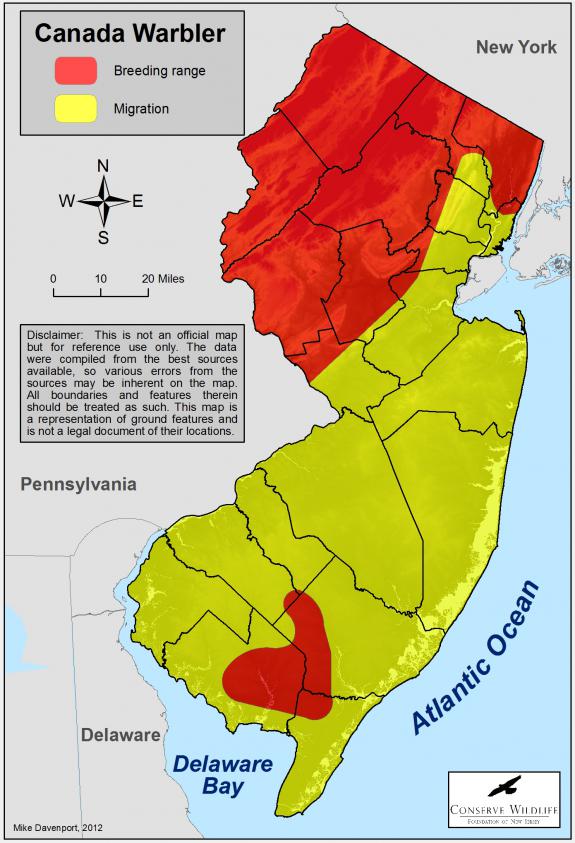Wilsonia canadensis
Type: bird
Status: special concern
Species Guide
Canada warbler
Wilsonia canadensis
Species Type: bird
Conservation Status: special concern
IDENTIFICATION
The Canada warbler is a small migratory songbird about 5-5 ¾ inches in length. The male is solid gray above and bright yellow below with a “necklace” of short black stripes. The female and immature individuals look similar to the male but have a fainter necklace or lack it entirely. All individuals have yellow “spectacles”.

Distribution & Habitat
The breeding range of the Canada warbler extends from southeastern Yukon in the northwest, throughout southern Canada, to southern New England in the northeast to as far south as northern Georgia. It winters in northern South America and migrates throughout Central American and eastern Mexico.
Breeding habitat includes moist thickets of woodland undergrowth, bogs, shrubs along streams or near swamps, and deciduous second growth. During the winter, their habitat consists of forested areas of foothills and mountains.
Diet
Canada warblers are insectivorous. They will feed on mosquitoes, beetles, flies, moths, caterpillars, as well as other insects.
Life Cycle
The breeding season for the Canada warbler in New Jersey is between mid-May and early to mid-August.
Nests are built by the female and are on or near the ground, among tree roots, cavities in stream banks, sides of rocks, stumps, or fallen logs, or on the ground under shrubs. Between 3 to 5 eggs are laid in May or June and incubation lasts about 12 days. The young are tended to by both parents. There is a single brood during the breeding season.
Current Threats, Status, and Conservation
The Canada warbler has undergone a decline in population over the last several decades throughout portions of its range including New Jersey. Such declines are most likely due to forest fragmentation and forest maturation within their breeding range as well as habitat loss within their nonbreeding range. It is listed as a Species of Special Concern in New Jersey (not yet endangered or threatened but possibly on its way).
Preservation of large areas of habitat with some site disturbance which promotes the development of a dense shrub layer benefits this species. Conservation of New Jersey’s warbler species requires long-term monitoring and research, habitat preservation and restoration, reduction in mortality caused by humans, cowbird control, and incentives to promote habitat preservation within their wintering areas.
References
Text written by Michael J. Davenport in 2011.
Scientific Classification
- Kingdom: Animalia
- Phylum: Chordata
- Class: Aves
- Order: Passeriformes
- Family: Parulidae
- Genus: Wilsonia
- Species: W. canadensis